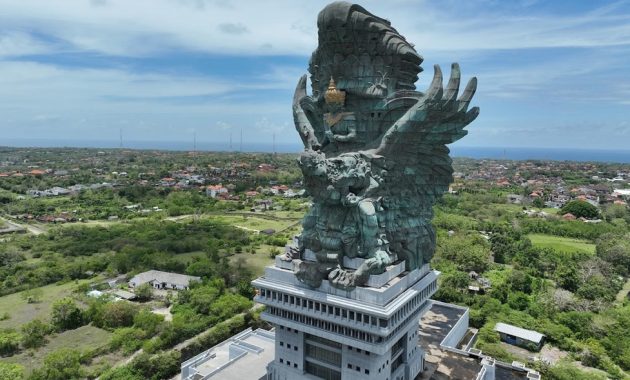
Standing tall at 121 meters, the Garuda Wisnu Kencana (GWK) Cultural Park is one of Bali’s most iconic landmarks and a symbol of the island’s spirituality and artistry. Located in Jimbaran, South Bali, GWK is home to one of the tallest statues in the world—a majestic depiction of Lord Vishnu riding the mythical bird Garuda. Beyond its sheer size, the park is a vibrant hub for Balinese culture, art, and performances, making it a must-visit destination for travelers seeking both awe-inspiring views and cultural immersion.
The Story Behind Garuda Wisnu Kencana
The GWK statue represents Lord Vishnu, one of Hinduism’s supreme deities, riding on Garuda, a mythical eagle-like bird who is his loyal companion. In Balinese and Hindu mythology, Garuda symbolizes freedom and selflessness, while Vishnu represents protection and preservation of the universe.
The project began in 1997 by Balinese artist Nyoman Nuarta but faced financial and political hurdles before finally being completed in 2018. Today, the statue stands taller than the Statue of Liberty and has become a modern cultural and spiritual icon of Bali.
Highlights of Garuda Wisnu Kencana Cultural Park
1. The GWK Statue
- At 121 meters tall, the statue is one of the tallest in the world.
- Its copper-and-brass construction took more than two decades to complete.
- Visitors can admire the statue from different angles, with its intricate details shining at sunrise and sunset.
2. Lotus Pond
The Lotus Pond is the park’s largest outdoor area, often used for concerts, exhibitions, and festivals. With the statue in the background, it creates a dramatic setting for cultural performances.
3. Cultural Performances
- Traditional Balinese Dances: Barong, Kecak, and Legong performances are staged daily.
- Music Performances: Live gamelan orchestras fill the air with mystical Balinese rhythms.
- Special Events: Occasional contemporary concerts and international shows are hosted here.
4. Street Theater & Street Arts
The park often features roaming performers, art installations, and parades, giving visitors a lively cultural experience.
5. Exhibition Halls & Galleries
Inside the cultural park are art galleries showcasing Balinese painting, sculpture, and craftwork, connecting traditional culture with modern artistic interpretations.
6. Panoramic Views
From the GWK hilltop, you can enjoy 360-degree views of Bali, stretching from Jimbaran Bay to Mount Agung and even Nusa Dua.
Festivals and Events at GWK
GWK is not just a tourist attraction but also a major venue for national and international events.
- Bali Arts Festival – A month-long celebration of Balinese culture.
- Concerts & International Performances – The Lotus Pond has hosted world-class artists.
- Religious Ceremonies – Certain Hindu festivals include rituals held at GWK.
Dining and Shopping at GWK
- Beranda Resto: Offers Balinese and Indonesian buffets.
- Food Court & Cafes: Affordable dining options for families.
- Souvenir Shops: Handmade Balinese crafts, mini-statues, and cultural merchandise are available.
Practical Visitor Information
Location: Jimbaran, South Kuta, Bali (approx. 20 minutes from Ngurah Rai International Airport)
Opening Hours: Daily, 8:00 AM – 10:00 PM
Entrance Fee:
- Adults: Around IDR 125,000
- Children: Around IDR 100,000
- (Extra fees for certain exhibitions or events)
Dress Code: Casual but respectful attire recommended.
Facilities: Shuttle service inside the park, wheelchair access, prayer rooms, and guided tours available.
Best Time to Visit GWK
- Morning (8–10 AM): Cooler weather, fewer crowds, great for exploring galleries.
- Late Afternoon (4–6 PM): Perfect for catching cultural shows and enjoying sunset views over the statue.
- Evening (7–9 PM): Ideal for night performances and illuminated views of the statue.
FAQs About Garuda Wisnu Kencana
How tall is the Garuda Wisnu Kencana statue?
The statue is 121 meters tall, making it taller than the Statue of Liberty.
Is GWK Cultural Park worth visiting?
Yes, it combines cultural shows, art exhibitions, panoramic views, and one of the world’s tallest statues.
Can you go inside the GWK statue?
Currently, the statue is not open for visitors to enter inside.
How much time should I spend at GWK?
At least 2–3 hours to fully explore the statue, exhibitions, performances, and dining options.
Is Garuda Wisnu Kencana family-friendly?
Absolutely! Children can enjoy the cultural performances, wide open spaces, and art installations.
What is the best way to get to GWK?
By taxi, private driver, or ride-hailing apps like Grab or Gojek.
Are there cultural shows every day?
Yes, daily dance and music performances are held at scheduled times.
Can I buy GWK tickets online?
Yes, GWK tickets are available online for convenience and faster entry.
What should I wear when visiting GWK?
Comfortable clothing and shoes, as the park involves some walking.
Is photography allowed inside GWK?
Yes, photography is allowed throughout the park, though drones may require special permission.
What are the dining options inside GWK?
Beranda Resto offers buffet dining, while smaller cafes and food stalls serve local snacks.
Is GWK included in Bali cultural tours?
Many tour packages include GWK along with Uluwatu Temple, Jimbaran Bay, or Nusa Dua.
Final Thoughts
The Garuda Wisnu Kencana Cultural Park is more than just a tourist attraction—it is a symbol of Bali’s spiritual identity and artistic legacy. Whether you’re marveling at the massive statue, enjoying traditional performances, or taking in panoramic island views, GWK offers a unique cultural journey. A visit here should be high on your Bali itinerary, especially if you want to experience the blend of heritage, art, and modern cultural pride.